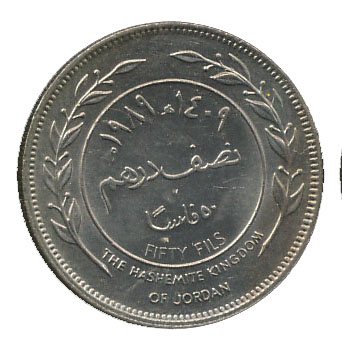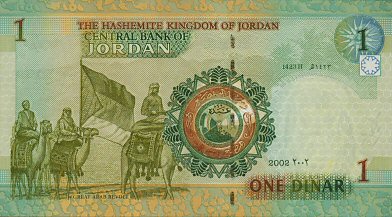|


The dinar (ISO 4217 code JOD; unofficially known as JD) is the currency of Jordan. The dinar is divided into 10 dirham, 100 qirsh (also called piastres) or 1000 fils.
The Jordanian dinar continued to be used in the West Bank along with Israeli currency after Israel conquered it in 1967. During Israel's hyperinflation in the 1970s and 1980s, the Jordanian currency provided stability.
Although the "toman" is no longer an official unit of Iranian currency, Iranians commonly express amounts of money and prices of goods in "tomans." For this purpose, one "toman" equals 10 rials. Despite this usage, amounts of money and prices of goods are virtually always written in rials. For example, the sign next to a loaf of bread in a store would state the price in rials, e.g., "200 Rials," even though the clerk, if asked, would say that the bread costs "20 tomans."
History
Before 1949, Jordan used the Palestinian pound as its currency. The dinar was introduced at par with this pound.
Until 1992, coins were denominated in Arabic using fils, qirsh, dirham and dinar but in English only in fils and dinar. Since 1992, the fils and dirham are no longer used in the Arabic denominations and the English denominations are given in dinar and either qirsh or piastres.
For a wider history surrounding currency in the region, see British currency in the Middle East.
Coins
Coins were introduced in 1949 in denominations of 1, 5, 10, 20, 50 and 100 fils. The first issue of 1 fils were mistakenly minted with the denomination given as "1 fil". 20 fils coins were minted until 1965, with 25 fils introduced in 1968 and ¼ dinar coins in 1970. The 1 fils coin was last minted in 1985. In 1996, smaller ¼ dinar coins were introduced alongside ½ and 1 dinar coins.
Banknotes
In 1949, banknotes were issued by the government in denominations of 500 fils, 1, 5 ,10 and 50 dinar. From 1959, the Central Bank of Jordan took over note production. 20 dinar notes were introduced in 1977, followed by 50 dinar in 1999. ½ dinar notes were replaced by coins in 1999.
Fixed exchange rate
Since October 23, 1995, the dinar has been officially pegged to the IMF's Special Drawing Rights (SDRs). In practice, it is fixed at 1 U.S. dollar = 0.709 dinar most of the time, which translates to approximately 1 dinar = 1.41044 dollars. The Central Bank buys U.S. dollars at 0.708 dinar, and sell U.S. dollars at 0.710 dinar.
The text on this page has been made available under the Creative Commons Attribution-ShareAlike License and Creative Commons Licenses
| 